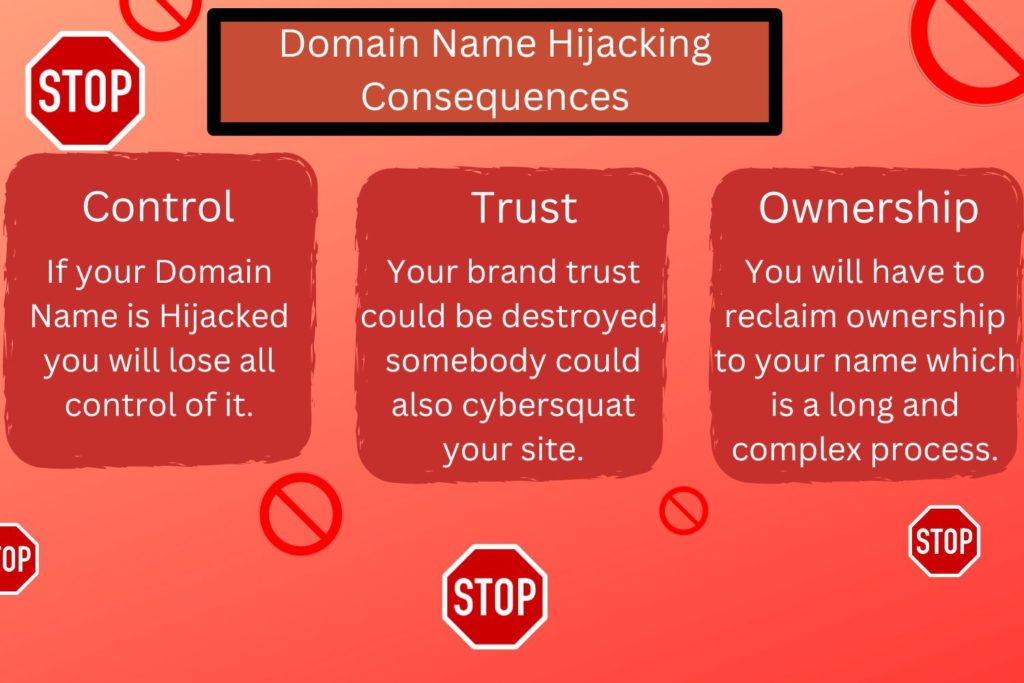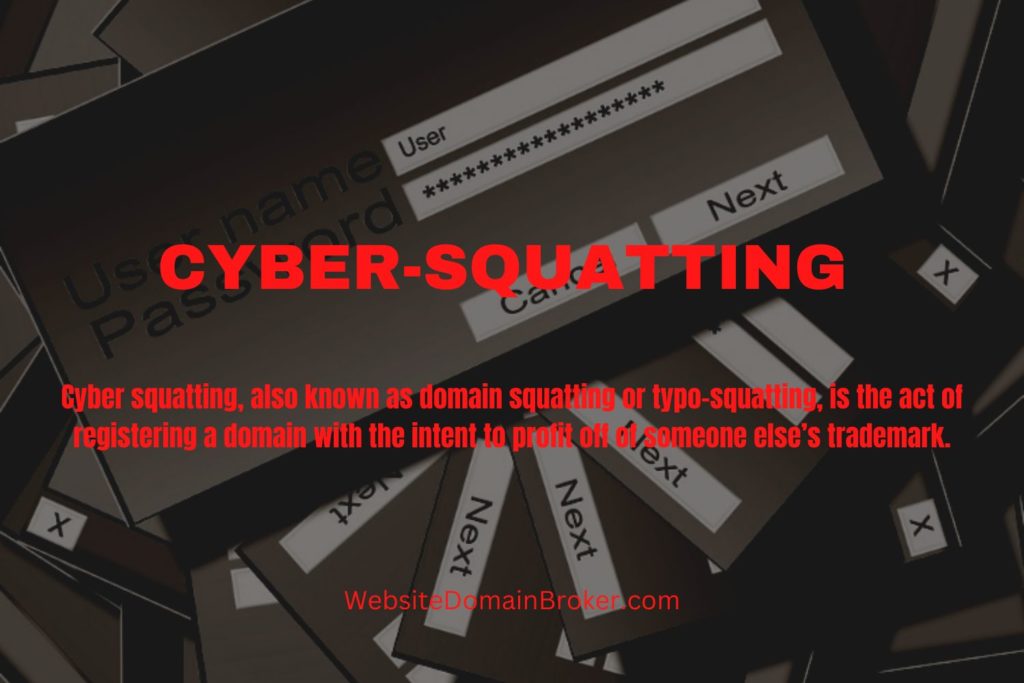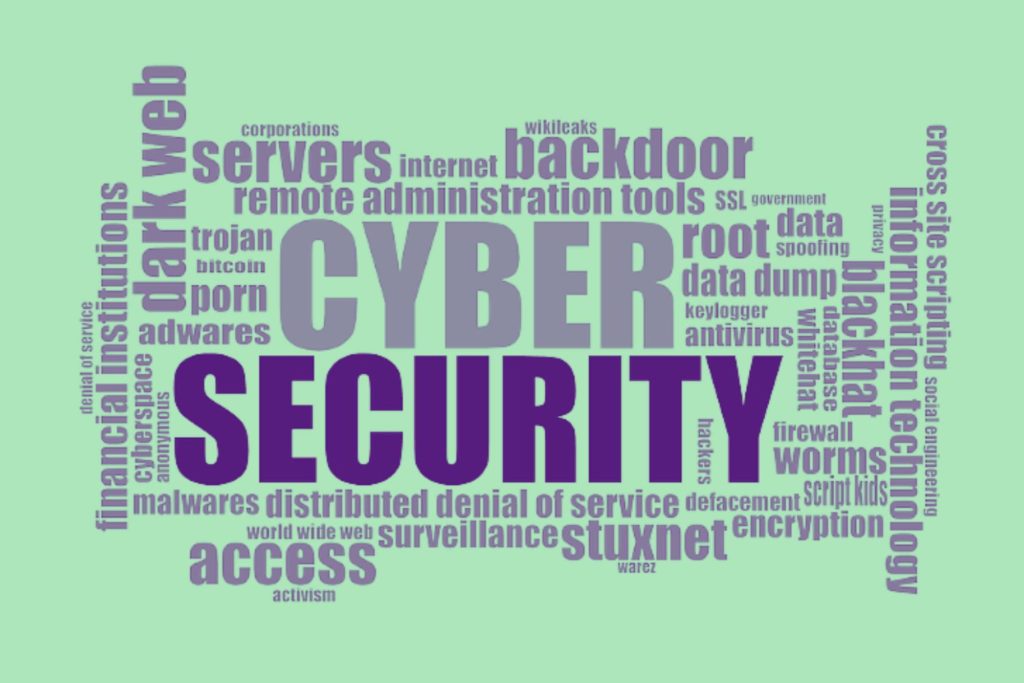
Domain name Hijacking.
Are you worried about your domain being hijacked or falling victim to cybersquatting?
Protecting your online presence is crucial for maintaining a successful website and brand.
Domain hijacking is a form of identity theft that will have extreme consequences to a domain owner if it happens.
Fortunately, there are steps you can take to prevent and protect against domain hijacking.
From keeping software and security tools updated, to working with a reputable web hosting provider, these tips can help safeguard your domain name and online presence.
The consequences of your domain being hijacked.
If your domain is hijacked, you may lose control of your website and any associated email addresses.
This can result in loss of revenue, damage to your reputation or credibility, and difficulty regaining control of the domain in the future.
It’s also possible for sensitive personal or financial information to be compromised if the attacker gains access to your website.
Domain locking can happen, and your email address will be stolen.
Taking steps to prevent hijacking can help minimize these consequences and protect your online presence.
7 steps to take for domain name security
- Use a secure and unique and strong password for your domain registrar account and regularly update it.
- Enable two-factor authentication for all login attempts to your domain registrar account.
- Monitor for any unauthorized changes to the contact information associated with your domain name.
- Consider registering additional variations of your domain name (such as .net or .biz) to prevent cybersquatters from grabbing them.
- Stay up to date on current threats and educate yourself on best practices for protecting your online assets.
- Keep all software and security tools on your website or server updated to prevent vulnerabilities that can be exploited by attackers.
- Work with a reputable and experienced web hosting provider who takes security seriously
What is Domain Name Hijacking?
Domain name hijacking is the unauthorized transfer of a domain name from its current registrant to another party.
This can happen through fraudulent means, such as gaining access to someone’s account credentials, social engineering or exploiting vulnerabilities in the domain registration system.
Cyber squatting and domain name hijacking.

Cyber squatting, or registering a domain with the intent to profit off of someone else’s trademark, is also a form of domain hijacking.
Regardless of the method, this illegal activity can have serious consequences for businesses and individuals who rely on their domain for their online presence and reputation.
Protecting your domain involves strong security measures such as unique and secure passwords, enabling two-factor authentication, and staying vigilant against phishing attempts.
It’s also important to regularly check that your contact information on file with your registrar is up to date in case there are any suspicious transfers attempted.
If your domain is hijacked, promptly contacting both your registrar and law enforcement can help with recovery efforts.
Examples of successful domain hijacking attacks.
One well-known example is when domain hijackers hacked the Twitter domain in 2009 and redirected it to a site that displayed pro-Turkish messages.
In 2013, a group of hackers successfully transferred ownership of several domains belonging to the government of South Korea, including president.go.kr and kriss.kr.
Another high profile case was when Microsoft’s live.com and msnbc.com were briefly hijacked in February 2011, redirecting visitors to a website containing the message “This site has been hijacked by Iranian Cyber Army.”
It’s not just big companies and government agencies that are at risk of domain hijacking – it can happen to anyone who owns a domain name.
It’s important to take preventative measures to protect yourself and your online presence.
Cyber squatting and how it happens

Cyber squatting, also known as domain squatting or typo-squatting, is the act of registering a domain with the intent to profit off of someone else’s trademark.
This can happen by registering misspellings or variations of a brand name, such as gogle.com or amazoon.com.
It often involves setting up a website that imitates the official brand site in order to trick visitors into sharing personal information or making purchases.
Cyber squatters may also try to sell the domain to the rightful owner at an inflated price.
The Anti-cybersquatting Consumer Protection Act (ACPA) was passed in 1999 to provide legal recourse for those affected by cyber squatting actions.
However, it’s still important to prevent it from happening in the first place by regularly monitoring for potential cyber squatters and acting against them.
Protecting your brand and domain names involves registering any variations or misspellings that may be susceptible to cybersquatting, and actively enforcing your trademark rights.
If you believe someone is cybersquatting on your brand, contacting both the registrar and a legal professional can help with resolving the situation.
How to Protect your Domain from getting Hijacked.
Some tips for protecting your premium domain from hijacking include:
– Use strong and unique passwords, and enable two-factor authentication if possible
– Keep your contact information on file with the registrar up to date
-Checking your DNS record often.
– Regularly monitor for any suspicious activity or unauthorized changes
– Stay vigilant against phishing attempts
– Promptly contact both the registrar and law enforcement if your domain is hijacked.
It’s also important to stay informed about cybersecurity best practices and any updates or vulnerabilities in the domain registration system. Taking these precautions can help protect you from becoming a victim of domain hijacking.
The consequences of a hijacked domain and how it could affect your domain name in the future.
If your domain is hijacked, it can result in loss of website traffic and potential customers, damage to your brand’s reputation and trust, and financial losses. In extreme cases, it can even lead to legal consequences and penalties.
A hijacked domain can also make it harder to recover and regain control in the future, as hackers may continue to change your contact information and password. This can result in a drawn out and complicated process of proving ownership and regaining access.
Taking steps to prevent hijacking, as well as staying vigilant and acting quickly if it does occur, can help minimize the consequences and protect your domain name in the long run.
Recovering from a domain hijacking can be difficult and time-consuming. There may also be long term repercussions, such as decreased credibility or difficulty regaining control of the domain in the future.
Taking steps to prevent hijacking is crucial in protecting not only your current online presence, but also your future success.
Keep all software and security tools on your website or server updated to prevent vulnerabilities that can be exploited by attackers.
It’s important to regularly update any software or security tools on your website or server. This can help prevent vulnerabilities that may be exploited by attackers looking to hijack your domain.
Make sure to keep track of updates, and set up automatic updates if possible. It’s also a good idea to periodically check for any security breaches and address them promptly.
Keeping your website and server up to date with the latest security measures can help protect against domain hijacking and other cyber attacks. It’s also a good idea to periodically check for any known security vulnerabilities and take steps to address them as needed.
Staying on top of updates and potential threats can help protect against domain hijacking and other cybersecurity incidents.
Web hosting providers that have the best domain name security.

Some domain name registrars and web host providers that have a reputation for strong domain name security include:
– Bluehost
It’s important to do your own research and choose a provider that fits your specific needs and offers the level of security you require.
It’s also a good idea to look for any customer reviews or industry recognition related to their security measures.
Working with a reputable and experienced web hosting provider who takes security seriously can also help protect your domain from hijacking.
Look for a provider that offers secure options such as SSL encryption and regular backups, and regularly monitors for threats. It’s also important to choose a provider that has experience handling and preventing security incidents, in case any do occur.
Choosing a reliable and secure web hosting provider is another step you can take to protect against domain hijacking and other cyber-attacks.
Domain name Spoofing

Phishing for a domain name involves trying to trick the owner into giving up login credentials or other sensitive information related to their domain.
Domain name spoofing is when attackers use a similar or slightly altered version of a legitimate domain in an attempt to deceive users and gain access to sensitive information.
Both tactics can lead to domain hijacking, so it’s important to be cautious of any suspicious emails or website addresses and take steps to protect your login credentials.
Summary
Overall, preventing domain hijacking and cybersquatting involves staying vigilant and taking proactive steps to protect your online presence.
From keeping software and security measures up to date, to choosing a reputable web hosting provider, these tips can help safeguard your domain name and website.
Don’t let someone else take control of your online identity – stay proactive in protecting against domain hijacking and cybersquatting.
Quick actions you can take.
Read the top five domain brokers to understand how the best brokers can help you.
For more valuable information on domain names, acquisition, branding, and hijacking, read :Everything you need to know about Domain Name Acquisition, Brand Hijacking, and Expired Domains.
For
